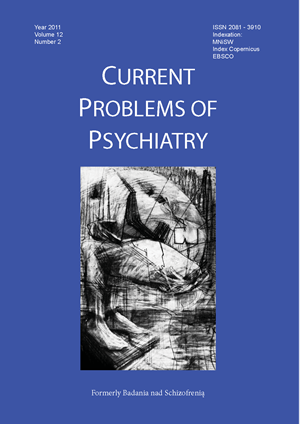Safety of vaginal disinfection with 3% alcohol iodine solution after cesarean section: thyroid function assessment in postpartum women with no risk factors for thyroid gland
Keywords:
iodine solution, puerperium, thyroid gland hormonesAbstract
Objective: To prospective evaluate the influences of vagina desinfection with 3% alcohol iodine solution on thyroid function in puerperium women living in areas with iodine sufficient supplementation.
Study design: Thirty one females with no personal and familiar history of thyroid diseases underwent vaginal disinfection with 3% alcohol iodine solution after cesarean section. The study finished twenty eight of them. All females we sampled for TSH and FT4 before cesarean section, after one and three months respectively.
Results: The mean TSH and FT4 levels of analyzed group stayed in laboratory normal range. Fourteen percent of examined puerperium women developed TSH level depresion. One patient expand overt hypothyroidism (3.5%).
Conclusions: Women after administration of large amount of iodine should be under accurate control in puerperium period.
References
1. Szybiński Z., Delange F., Lewinski A., Podoba J., Rybakowa M., Wasik R., et al. A programme of iodine supplementation using only iodised household salt is efficient - the case of Poland. Eur. J. Endocrinol., 2001; 144(4): 331-337.
2. Lewinski A., Szybinski Z., Bandurska-Stankiewicz E., Grzywa M., Karwowska A. Kinalska I. et al. Iodine-induced hyperthyroidism - an epidemiological survey several years after institution of iodine prophylaxis in Poland. J. Endocrinol. Invest., 2003; 26(Suppl.2): 57-62.
3. Aghini-Lombardi F., Antonangeli L., Martino E., Vitti P., Maccherini D., Leoli F. et al. The Spectrum of Thyroid Disorders in an Iodine-Deficient Community: The Pescopagano Survey. J. Clin. Endocrinol. Metab., 1999; 84(2): 561-566.
4. Dohan O., De la Vieja A., Carrasco N. Molecular Study of sodiumiodide symporter (NIS): a new filed in thyroidology. Trends Endocrinol. Metab., 2000; 11(3): 99-105.
5. Delange F. Iodine deficiency in Europe and its consequences: an update. Eur. J. Nucl. Med. Mol. Imaging., 2002; (Suppl.2): 404-416.
6. Demers L.M., Spencer C.A. Laboratory medicine practise guidelines: laboratory support for the diagnosis and monitoring of thyroid disease. Clin. Endocrinol. (Oxf)., 2003; 58(2): 138-140.
7. Baloch Z., Carayon P., Conte-Devolx B., Demers L.M., Feldt-Rasmussen H., Henry I.F., et al. Guidelines Committee, National Academy of Clinical Biochemistry: Laboratory medicine practice guidelines. Laboratory support for the diagnosis and monitoring of thyroid disease. Thyroid, 2003; 13(1), 3-126.
8 Bostanci I., Sarogliu A., Ergin H., Aksit A., Cinbis M., Akalin N. Neonatal goiter caused by expectorans usage. J. Pediatr. Endocrinol. Metab., 2001; 14(8): 1162-1162.
9. Semba R., Delange F. Iodine in human milk: Perspectives for infant health. Nutr. Rev., 2001; 59(8): 269-278.
10. Paravacini E., Fontana C., Paterlini G., Taglianbe P., Rovelli F., Leung K., et al. Iodine, thyroid function, very low birth weight infants. Pediatrics, 1996; 98: 730-34.
11. Harada S., Ichihara N., Arai J., Honma H., Matsuura N., Fujieda K. Influence of iodine excess due to iodine-containing antiseptics on neonatal screening for congenital hypothyroidism in Hokkaido prefecture. Screening 3, 1994; 3: 115-123.
12. Howard R. Appriopriate use of topical antimicrobials and antiseptics in children. Pediatr. Ann., 2001; 30(4): 219-225.
13. Bostanci I., Sarogliu A., Ergin H., Aksit A., Cinbis M., Akalin N.: Neonatal goiter caused by expectorans usage. J. Pediatr. Endocrinol. Metab., 2001; 14(8): 1162-1162.
14. Richards K., Stasko T. Dermatologic surgery and the pregnant patient. Dermatol. Surg., 2002; 28(3): 248-256.
15. Heymann W.R. Potassium iodide and the Wolf-Chaikoff effect: relevance for dermatologist. J. Am. Acad. Dermatol., 2000; 42: 490-492.
16. Reid V.C., Hartman K.E., Mc Mahon M., Fry E.P. Vaginal preparation with povidone-iodine prior to cesarean section did not reduce pospartum infection. Obstet. Gynecol., 2001; 3: 186-187.
17. Glinoer D. The regulation of thyroid function during normal pregnancy:importance of the iodine nutrition status. J. Clin. Endocrinol. Metab., 2004; 18(2) 133-152.
18. Bournaud C., Orgiazzi J. Iodine excess and thyroid autoimmunity. J. Endocrinol. Invest., 2003; 26(Suppl.2): 49-56.
19 Sakaihara M., Yamada H., Kato E., Ebina Y., Shimada S., Kobashi G., et al. Postpartum thyroid dysfuntion in women with normal thyroid funtion during pregnancy. Clin. Endocrinol., 2000; 53(4): 487-492.
20. Roti E., Uberti E. Post-partum thyroiditis – a clinical update. Eur. J. Endocrinol., 2002; 146(3): 275-279.
21. Laurberg P., Bullow Pedersen I., Knudsen N., Oversen L., Andersen S. Enviromental iodine intake affect the type of nonmalignant thyroid disease. Thyroid, 2001; 11(5): 457-469.
22. Diez J.J. Hyperthyroidism in patients older than 55 years: an analysis of the etiology and management. Gerontology, 2003; 49(5): 316-23.
23. Yang F., Teng W., Shan Z., Guan H., Li Y., Jin Y., et al. Epidemiological survey on the relationship between different iodine intakes and prevalence of hyperthyroidism. Eur. J. Endocrinol., 2002; 146(5): 613-618.
24. Lazarus J., Kokandi A. Thyroid disease in relation to pregnancy: A decade of change. Clin. Endocrinol., 2000; 53(3): 265-278.
25. Yilmaz D., Tezic H.T., Zorlu P., Firat S., Bilaloglu E., Kotlu A. Single dose povidone-iodine on thyroid functions and urinary iodineexcretion. Indian Journal of Pediatrics, 2003; 70(8): 675-677.
26. Garland J.S., Alex C.P., Otten D., Shivpuri C., Harris M.C., Naples M., et al. A randomised trial comparing povidone-iodine to chlorhexidine gluconate-impregnated dressing for prevention of central venous catheter infections in neonates. Pediatrics. 2001; 107(6): 1431-1438.
27. Morgan J., Haugl R., Kosman J. Antimicrobal Skin Preparation for the Maxillofacial Region. J. Oral Maxillofac. Surg., 1996; 54(1): 89-94.
Downloads
Published
Issue
Section
License
Copyright (c) 2011 Authors

This work is licensed under a Creative Commons Attribution-NonCommercial-NoDerivatives 3.0 Unported License.


